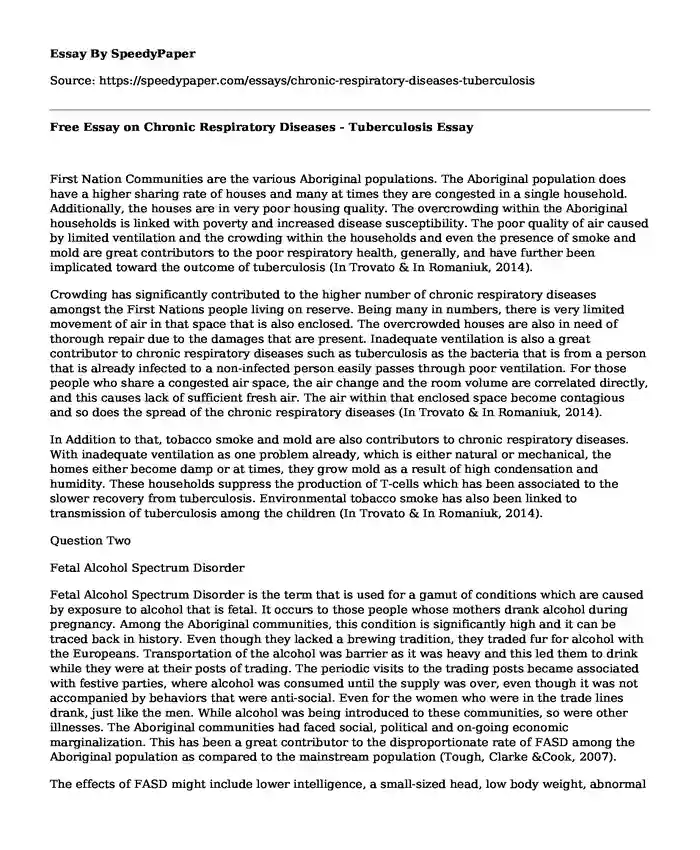
| Type of paper: | Essay |
| Categories: | Health and Social Care |
| Pages: | 3 |
| Wordcount: | 708 words |
First Nation Communities are the various Aboriginal populations. The Aboriginal population does have a higher sharing rate of houses and many at times they are congested in a single household. Additionally, the houses are in very poor housing quality. The overcrowding within the Aboriginal households is linked with poverty and increased disease susceptibility. The poor quality of air caused by limited ventilation and the crowding within the households and even the presence of smoke and mold are great contributors to the poor respiratory health, generally, and have further been implicated toward the outcome of tuberculosis (In Trovato & In Romaniuk, 2014).
Crowding has significantly contributed to the higher number of chronic respiratory diseases amongst the First Nations people living on reserve. Being many in numbers, there is very limited movement of air in that space that is also enclosed. The overcrowded houses are also in need of thorough repair due to the damages that are present. Inadequate ventilation is also a great contributor to chronic respiratory diseases such as tuberculosis as the bacteria that is from a person that is already infected to a non-infected person easily passes through poor ventilation. For those people who share a congested air space, the air change and the room volume are correlated directly, and this causes lack of sufficient fresh air. The air within that enclosed space become contagious and so does the spread of the chronic respiratory diseases (In Trovato & In Romaniuk, 2014).
In Addition to that, tobacco smoke and mold are also contributors to chronic respiratory diseases. With inadequate ventilation as one problem already, which is either natural or mechanical, the homes either become damp or at times, they grow mold as a result of high condensation and humidity. These households suppress the production of T-cells which has been associated to the slower recovery from tuberculosis. Environmental tobacco smoke has also been linked to transmission of tuberculosis among the children (In Trovato & In Romaniuk, 2014).
Question Two
Fetal Alcohol Spectrum Disorder
Fetal Alcohol Spectrum Disorder is the term that is used for a gamut of conditions which are caused by exposure to alcohol that is fetal. It occurs to those people whose mothers drank alcohol during pregnancy. Among the Aboriginal communities, this condition is significantly high and it can be traced back in history. Even though they lacked a brewing tradition, they traded fur for alcohol with the Europeans. Transportation of the alcohol was barrier as it was heavy and this led them to drink while they were at their posts of trading. The periodic visits to the trading posts became associated with festive parties, where alcohol was consumed until the supply was over, even though it was not accompanied by behaviors that were anti-social. Even for the women who were in the trade lines drank, just like the men. While alcohol was being introduced to these communities, so were other illnesses. The Aboriginal communities had faced social, political and on-going economic marginalization. This has been a great contributor to the disproportionate rate of FASD among the Aboriginal population as compared to the mainstream population (Tough, Clarke &Cook, 2007).
The effects of FASD might include lower intelligence, a small-sized head, low body weight, abnormal appearance, poor coordination, short height and even problems with seeing or hearing. A severe form of the condition is referred to as Fetal Alcohol Syndrome. The baby normally has a small mouth opening and small eye openings. The philtrum appears smoother and the upper lip is thinner. There are long term effects associated with this disorder such as drug and alcohol problems, legal problems, trouble at school and even participation in behaviors that are very risky (Tough et al., 2007).
The prevention strategy to combat FASD among the Aboriginal population would be to create more awareness against the effects drinking during pregnancy. The women need to be educated on the adverse effects that the baby develops due to her drinking during pregnancy (Tough et al., 2007).
References
In Trovato, F., & In Romaniuk, A. (2014). Aboriginal populations: Social, demographic, and Epidemiological perspectives.
Tough, S., Clarke, M., & Cook, J. (January 01, 2007). Fetal Alcohol Spectrum Disorder Prevention Approaches among Canadian Physicians by Proportion of Native/Aboriginal Patients: Practices during the Preconception and Prenatal Periods. Maternal and Child Health Journal, 11, 4, 385-393.
Cite this page
Free Essay on Chronic Respiratory Diseases - Tuberculosis. (2019, Oct 08). Retrieved from https://speedypaper.net/essays/chronic-respiratory-diseases-tuberculosis
Request Removal
If you are the original author of this essay and no longer wish to have it published on the SpeedyPaper website, please click below to request its removal:
- Project Management at Global Publishing. Free Essay Example.
- Free Essay about Forensic Report Examination
- Allegory Writing Essay Example
- Pepy's Diaries
- Essay Sample Comparing and Contrasting Two Theoretical Approaches to Counselling
- Essay Sample on Polarization of Political Parties and Centrist Politics
- High-Risk Nutritional Risk - Free Paper
Popular categories




